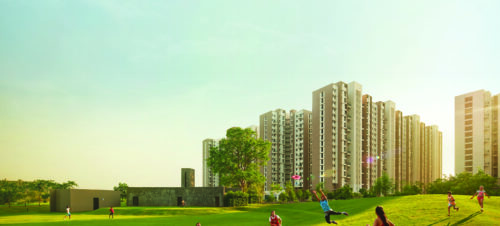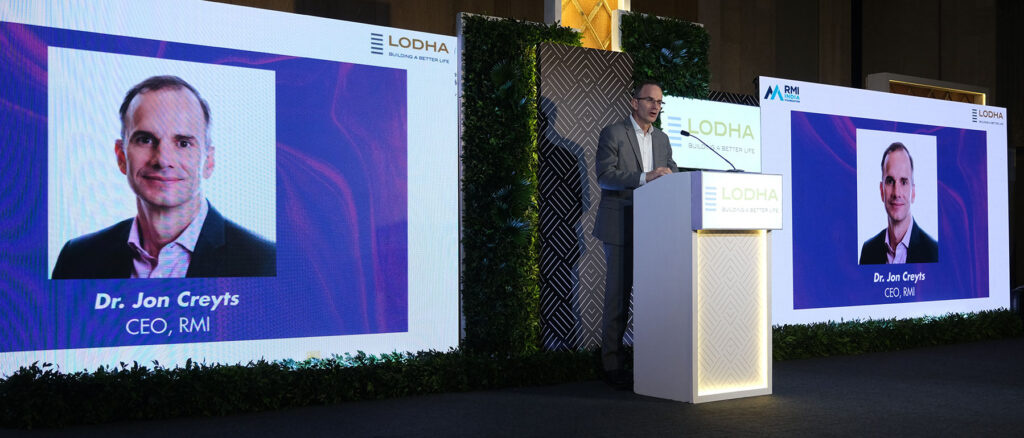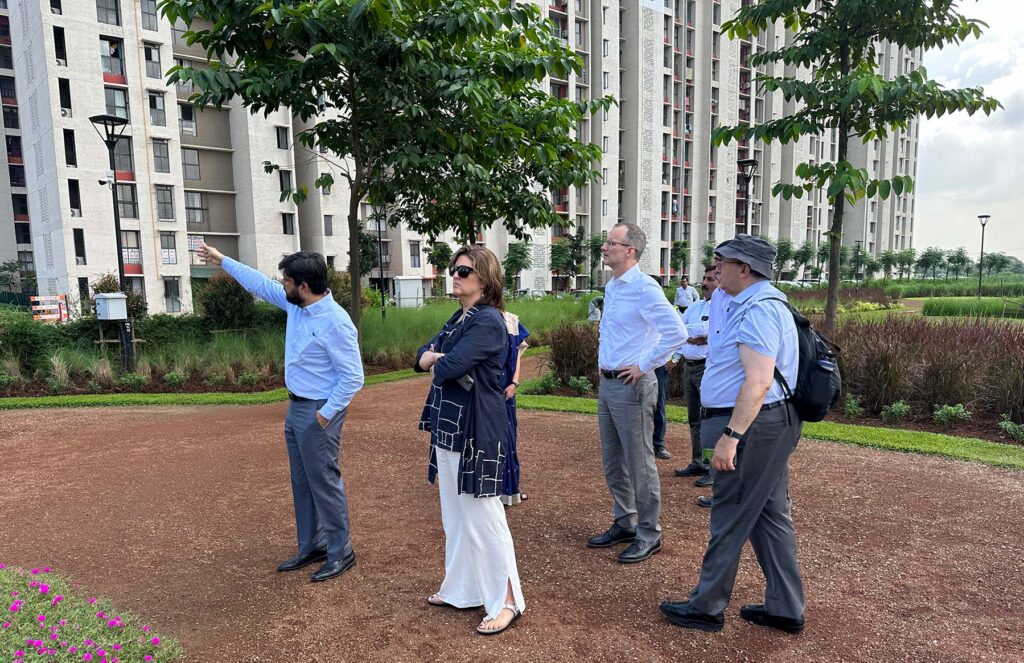
Dispatch from Mumbai: Experiencing the Urban Gem of Palava
A visit to India’s model net-zero energy city reveals a blueprint for the future.
Situated along the shores of the Arabian Sea, the metropolis of Mumbai displays a unique blend of modernity, culture, tradition, and fast-paced, undeterred development. With skyscrapers alongside art deco buildings and centuries-old temples alongside an active seacoast, the city has buildings of every shape, size, and form.
This fall, I visited Mumbai to participate in the RMI – Lodha Sustainability Conclave, a flagship two-day event to build collaborative capacity among government, industry, and academic leaders to help India decarbonize its buildings faster. The event was hosted by Lodha — India’s largest real estate developer — and featured cross-functional teams working to identify and scale innovative sustainable solutions in low-carbon building materials, cooling, clean energy, and electric vehicles.
It is no secret that the global economy is poised to dramatically expand by 2050. And with the fastest growth rate on the planet, India will certainly be a driver of this expansion, with estimates indicating its share of global GDP may eventually surpass that of the United States. This economic progress offers city planners, developers, and a host of similarly positioned stakeholders a unique opportunity to incorporate cutting-edge energy efficiency and sustainable design practices.

A model – and lab – for urban living
In 2018, RMI India was engaged by Lodha to collaborate on sustainability planning for its Palava City Development, India’s flagship net-zero energy city. We have been engaged continuously with Lodha since. The vision of Palava City is to create a next-generation sustainable district that inspires new developments within India and internationally. Located close to the New Mumbai development (Navi Mumbai), this 4,500-acre expanse is India’s first greenfield smart city. Its vision is to offer a model of urban living for the 70 percent of the global population projected to dwell in urban settings by 2050 that is sustainable, livable, and affordable.
But the development is more than just a model of compact urban sustainable development. It is also a living lab to experiment with new ideas, new designs, and new technologies and learn across system boundaries. It involves a partnership with suppliers to integrate best practices and accelerate learning. The site is set up with instrumentation and survey capabilities to help understand from buildings and tenants alike what is working and what is not, and to support continuous concept improvement.
I arrived in India eager to visit Palava City and engage with participants in the accelerator about their experience so far, and what takeaways would benefit building decarbonization around the world. My excitement was immediately buoyed by what I saw.
Efficiency as a cornerstone
Before we began our workshop, Amory Lovins — RMI’s co-founder, often referred to as the Einstein of energy efficiency — and I joined a larger group to tour the Palava site. The tour revealed an efficiency dream in progress. The site is already home to 160,000 people, en route to an estimated one million inhabitants. It is a model of integrative design, considering carefully how work and leisure, mobility and structure, buildings and green space must all be in balance in one efficient and resilient whole. The planning of Palava mirrors in many ways the beauty of Amory’s home — constructed four decades ago as a passive and sustainable structure housing a rainforest in its atrium despite being deep in the mountains of Colorado — but on a much larger scale.
The team at Lodha have taken a comprehensive approach to efficiency, from selecting low-emissions construction materials to energy-efficient appliances, and everything in between. We saw how the housing units across categories incorporate a range of passive design features, such as optimal orientation, window shading, energy-efficient glass, and efficient cooling systems, significantly reducing energy consumption while enhancing living conditions. They also use green space and building color to help minimize the cooling load in the first place.
As a living lab, they had already iterated on the recipes for energy savings through the initial three phases of development, where there were obvious changes in design and construction practices. While we were there, we even had a chance to tour an apartment where they were preparing to test a five-fold more efficient air conditioning system that recently won the Global Cooling Prize competition.

Renewable energy, green spaces, and more
With over 4 MW of solar panels adorning the township and solar water heaters in every building, Palava’s commitment to energy and emissions reduction is evident. Their aim is to equip all structures with enough solar panels to meet 100 percent of communal energy requirements. This is well aligned with what Lodha is already doing as a group; 95 percent of its operational energy needs come from renewable sources.
From the start, Palava was envisioned with abundant open green spaces, comprising 25 percent of the city's footprint. The urban form ensures that residents have everything from schools to retail areas within a 15-minute walk. This proximity reduces the need for vehicle travel, promoting a healthier lifestyle and reducing carbon footprints.
Climate change resilience is another cornerstone of Palava's design. Recognizing environmental changes afoot, the designers have incorporated findings from physical climate risk studies and designed a city to be resilient for the anticipated weather in 50 years. Doing so requires that the city's layout respects natural attributes, from contours to existing biodiversity, and works to promote natural flood management systems.
Fresh water management at Palava isn't just about ensuring supply. It takes a holistic approach, balancing water availability, wastewater treatment, and sustainable usage. With the community treating and reusing 100 percent of its greywater and blackwater, Palava is pioneering responsible resource management.
The power of collaborative problem-solving
After visiting the site, the combined RMI and Lodha teams facilitated two days of highly interactive workshops with nearly 100 partners and collaborators focused on distilling learnings from Palava, proposing new solutions to test, and identifying ways to scale what is working across the broader built environment in India. Corporate representatives, investors, technologists, policymakers, and thought leaders all crowded around flipcharts and worked furiously on four critical challenges: 1) how to create markets for low-carbon building materials in India, 2) how to get more cost-effective cooling in Indian buildings given the increasing exposure to lethal heat, 3) how to make sure that renewable power options are available to support every community, and 4) how to hasten the pace of electrification of vehicles for the residents and workers in India’s buildings. The insights around what’s working and what’s not were remarkable, but I was most encouraged by the clear alignment on what’s next, and how each of the different groups left with an action plan and a set of willing collaborators who were committed to work together to help change markets — beginning with the Palava site — but extending well beyond in ambition.
A blueprint for a sustainable future
As I left Mumbai, I was filled with hope and excitement. Palava is not just a testament to the fact that we can technically build better cities that solve climate change by design, but also that a collaborative process is the way to get there fastest. Palava proves that we can build vibrant, sustainable cities today at affordable price points using local capacity. It just takes a few leaders like Lodha to provide the vision and rally the engagement, and we’ll quickly shift from net-zero cities being possible to prevalent not just in India, but across the fastest growing regions on the planet.